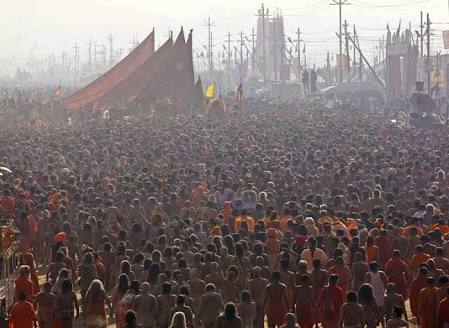Khumbh Mela Festival In India Is Most Gathering On Earth.
Kumbh Mela, also called Kumbha Mela, in Hinduism, religious festival that is celebrated four times over the course of 12 years, the site of the observance rotating between four pilgrimage places on four sacred rivers—at Haridwar on the Ganges River, at Ujjain on the Shipra, at Nashik on the Godavari, and at Prayag (modern Allahabad) at the confluence of the Ganges, the Jamuna, and the mythical Sarasvati. Each site’s celebration is based on a distinct set of astrological positions of the Sun, the Moon, and Jupiter, the holiest time occurring at the exact moment when these positions are fully occupied. The Kumbh Mela at Prayag, in particular, attracts millions of pilgrims. In addition, a Great Kumbh Mela festival is held every 144 years at Prayag; the 2001 festival attracted some 60 million people.
Attendees at the Kumbh Mela come from all sections of Hindu religious life, ranging from sadhus (holy men), who remain naked year-round or practice the most severe physical discipline, to hermits, who leave their isolation only for these pilgrimages, and even to silk-clad teachers using the latest technology. The religious organizations represented range from social welfare societies to political lobbyists. Vast crowds of disciples, friends, and spectators join the individual ascetics and organizations. The naga akhadas, militant ascetic orders whose members formerly made their livings as mercenary soldiers and traders, often claim the holiest spots at each Kumbh Mela’s most propitious moment. Although the Indian government now enforces an established bathing order, history records bloody disputes between groups vying for precedence.
Tradition ascribes the Kumbh Mela’s origin to the 8th-century philosopher Shankara, who instituted regular gatherings of learned ascetics for discussion and debate. The founding myth of the Kumbh Mela—attributed to the Puranas (collections of myth and legend)—recounts how the gods and demons fought over the pot (kumbha) of amrita, the elixir of immortality produced by their joint churning of the milky ocean. During the struggle, drops of the elixir fell on the Kumbh Mela’s four earthly sites, and the rivers are believed to turn back into that primordial nectar at the climactic moment of each, giving pilgrims the chance to bathe in the essence of purity, auspiciousness, and immortality. The term Kumbh comes from this mythic pot of elixir, but it is also the Hindi name for Aquarius, the sign of the zodiac in which Jupiter resides during the Haridwar Mela..jpg)
.jpg)
You give nice information about kumbamela thankyou